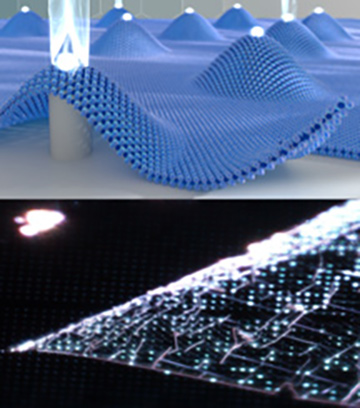 Top: Diagram of monolayer flake tenting over the nanopillars (not to scale). Bottom: Dark-field optical microscopy image (real color) of a monolayer WSe2 flake over the pillar sample. The hundreds of spots correspond to the locations at which the flake bends over the nanopillars; each of those points, to a near-unity yield, is a quantum light source.
Top: Diagram of monolayer flake tenting over the nanopillars (not to scale). Bottom: Dark-field optical microscopy image (real color) of a monolayer WSe2 flake over the pillar sample. The hundreds of spots correspond to the locations at which the flake bends over the nanopillars; each of those points, to a near-unity yield, is a quantum light source.
Two-dimensional semiconductors present a new potential solid-state host for single-photon sources. A notable characteristic of these systems compared with traditional single-photon sources, such as InGaAs quantum dots or color centers in diamond, is the ability to trap single-excitons at a surface. This asset could unlock the potential for developing highly efficient photon extraction mechanisms and for coupling confined excitons to photonic structures and other quantum systems.
Since 2015, single-photon emitting sites of unknown origin have been reported to appear at random locations in monolayer flakes of WSe2, WS2 and MoSe2.1,2 This year, we were able to deterministically engineer such sources at precise locations with a 96 percent yield, in unlimited numbers, in a scalable manner and with better optical properties than their randomly occurring counterparts.3
We accomplished this deterministic source by deforming the material locally at the nanoscale, using patterned substrates. We first exfoliated monolayer flakes of WSe2 and WS2 from bulk crystals. Then, we transferred the flakes onto silica substrates patterned with square arrays of nanopillars, spaced 4 µm apart and ranging from 100 to 200 nm in height and with a 90-nm apex diameter. Atomic-force microscopy scans show that the flakes tent over each nanopillar and attach by Van der Waals forces to the flat areas of the substrate in-between.
Low-temperature photoluminescence (PL) measurements showed a brightening of PL and narrow spectral lines from the pillar locations. Photon-correlation measurements on these narrow lines confirmed the single-photon nature of the emission, and high-resolution spectral measurements revealed a fine structure in the majority of dots. The parameters measured are very similar to those measured for the randomly appearing single-photon-emitting sites in the same materials, which suggests a common origin. Characterization of the quantum emission with increasing pillar height also yielded interesting results: the number of narrow lines per site decreases and the spectral wandering improves by an order of magnitude compared with the random emission sites.
We believe that this work paves the way for a true single-photon emitter that can be easily scaled up and integrated with other photonic components. In addition, as a new platform for deterministic quantum light-matter interaction between single-excitons and photons, it allows researchers to explore the potential for optical single-spin control toward quantum information applications.
Researchers
C. Palacios-Berraquero, Dhiren M. Kara, Alejandro R.-P. Montblanch, Matteo Barbone, Duhee Yoon, Anna K. Ott, Andrea C. Ferrari and Mete Atatüre, University of Cambridge, U.K.
Pawel Latawiec and Marko Loncar, Harvard University, Cambridge, Mass., USA
References
1. P. Tonndorf et al. Optica 2, 347 (2015).
2. C. Palacios-Berraquero et al. Nat. Commun. 7, 12978 (2016).
3. C. Palacios-Berraquero et al. Nat. Commun. 8, 15093 (2017).
